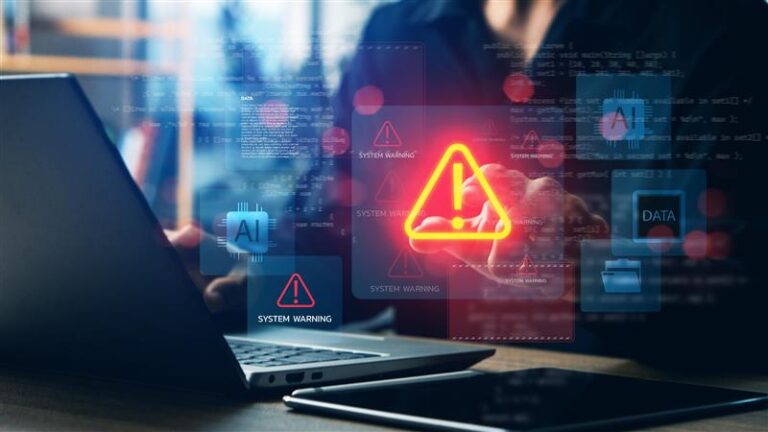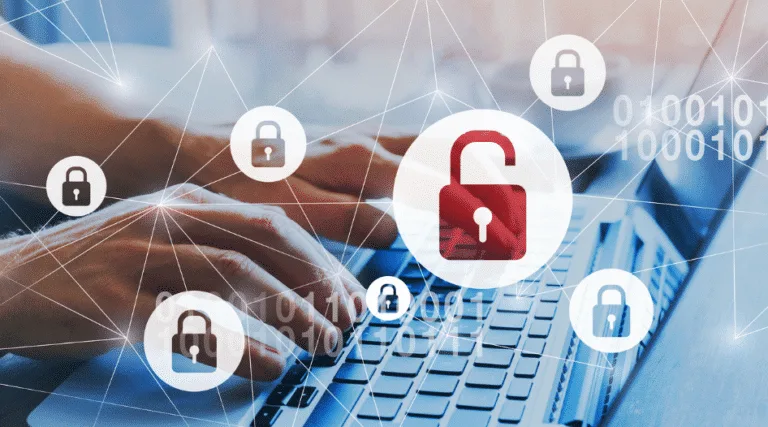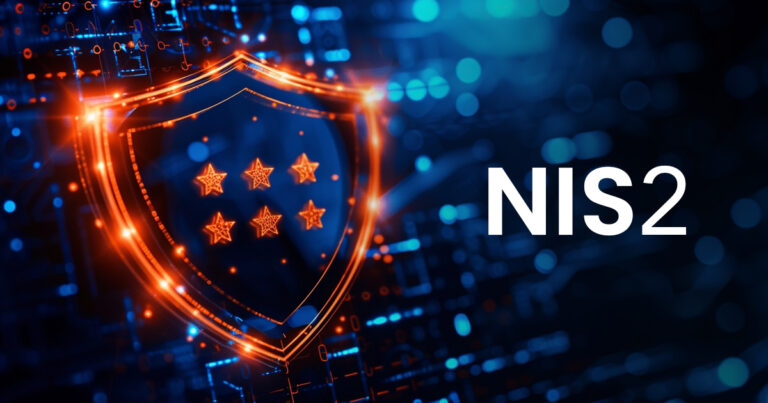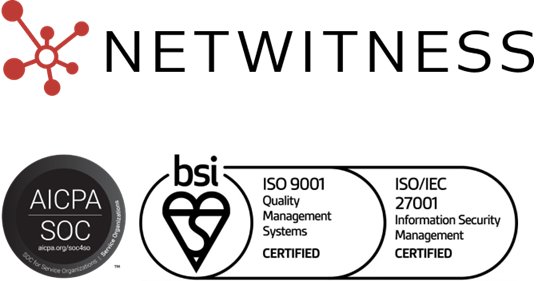Security Information and Event Management (SIEM) integrations are an essential part of any organization’s security arsenal. By connecting SIEM networking to other systems, organizations can ensure that all available logging data is monitored for potential threats and drive a more efficient response when a breach occurs. SIEM integrations also help organizations detect malicious activity quickly, allowing them to take action before damage is done.
In this article, we will explore the different types of SIEM integrations available, as well as how they can be used to better protect your organization from cyberattacks and why you should contact NetWitness to get started. We’ll also talk about some challenges and benefits of SIEM integrations, so if you’re ready to start, let’s dive into SIEM integrations at NetWitness.
What Is SIEM Integration?
SIEM integration is the process of connecting multiple security tools and data sources – such as firewalls, endpoints, servers, and cloud platforms to a centralized SIEM platform. Proper SIEM integration strengthens overall SIEM security by enabling unified monitoring, analytics, and incident response. It also enhances SIEM network monitoring by giving security teams a single view of activity across the environment.
What Is SIEM Technology?
Security Information and Event Management software SIEM technology can be used to detect, investigate, respond to, and monitor security threats or suspicious activity. SIEM solutions allow organizations to collect log data from various sources such as network devices, applications, databases, operating systems, users, and other sources in order to analyze it for potential threats. This data can then be used to identify and respond to potential threats, as well as build a better understanding of the organization’s security posture.
Some threats that SIEM technology can help monitor throughout your organization are malware, ransomware, phishing, DoS (Denial of Service), and many more. As the digital age evolves, more cyberattacks are being introduced by threat actors. Using NetWitness as your cyber security provider will help you stay ahead of the attacks as they surface. Protecting your bottom line is our top priority. Keep reading to learn more about NetWitness and SIEM integration.
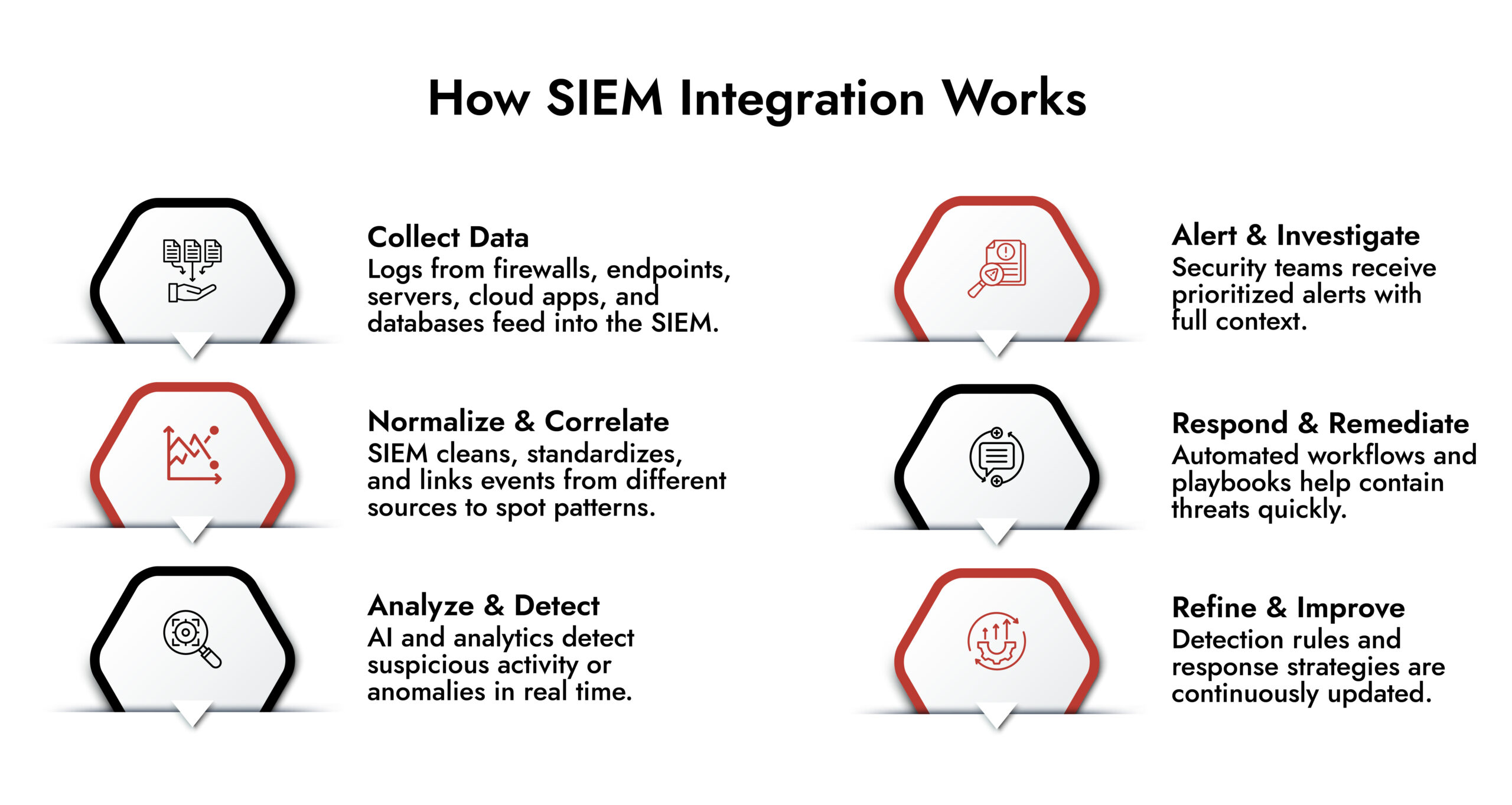
What Makes SIEM Integrations Essential to a Strong Security System?
SIEM integration is the process of connecting various security tools, systems, and data sources – like firewalls, endpoints, servers, and cloud platforms to a centralized SIEM platform for unified monitoring, analysis, and response. In today’s modern world, having a comprehensive security system is essential for businesses of all sizes. With the right security system in place, organizations can protect their assets and data from malicious activities such as hacking or theft. Moreover, by integrating the latest technology, such as SIEM integrations, businesses can improve the effectiveness of their security system and keep their operations running smoothly. Let’s take a closer look at why security systems with SIEM integrations are so important.
How Does SIEM Integrations Help Secure Your Data?
SIEM integrations provide businesses with an additional layer of protection for their data. By connecting systems together to share information across different applications in real time, it becomes much harder for unauthorized entities such as hackers or criminals to access or manipulate sensitive information. By using the latest technologies like artificial intelligence (AI) and machine learning (ML), organizations can improve their security systems. This helps them stay updated on the latest threats.
Advanced Detection Capabilities
Another benefit of implementing a comprehensive security system with SIEM integrations is the advanced detection capabilities it provides. By connecting existing systems together into a single platform, businesses can leverage powerful analytics tools to detect potential threats before they become an issue. For example, if there is suspicious activity on one system or application, responders in the security operation center (SOC) can be alerted immediately so that the necessary steps can be taken to prevent any damage from occurring. This greatly reduces the risk of downtime or data loss due to malicious attacks or other unforeseen circumstances.
In conclusion, investing in a comprehensive security system with SIEM integrations is an excellent way for organizations to protect their data while also realizing other benefits over time. These solutions provide an additional layer of protection against potential threats while also making it easier to detect suspicious activity before it becomes an issue. Investing in a comprehensive security system now will help ensure your business remains safe and secure for years to come.
What Can SIEM Integrations Do?
SIEM software solutions are used to provide visibility across the environment to detect cyber threats and to maintain the operational health of systems. It leverages log management capabilities and techniques to detect anomalies within your environment that could signify malicious activity. In this blog post, we’ll explore the different types of SIEM integrations and how they work together to protect your system against potential cyber threats.
1. Log Management
Log management is the process of collecting log-based data from various sources within a system in order to identify potential security risks or incidents. This is a core capability of SIEM networking and allows you to monitor what is happening in your system in real time so you can take action quickly if an issue arises. Additionally, log management can help you build up an audit trail that can be used for legal or compliance purposes down the line.
2. Network Monitoring and Analysis
SIEM network monitoring and analysis is a key ingredient within a SIEM integration and allows you to keep track of network activity within your system. So you can see in real time the activity of your network traffic.
3. Endpoint Detection
Endpoint detection and response allows you to view your activity across all your endpoints; bringing this data via a SIEM integration gives you an even better view into your environment. Because you’re able to monitor your endpoints you can cut down the time it takes to detect a threat and respond accordingly.
4. User and Entity Behavior Analytics (UEBA)
This is an analytics capability that typically uses machine learning to quickly identify threats or anomalies within your environment. One common approach is to build capabilities around an unsupervised data model, meaning that it starts working as soon as you turn it on and it begins to identify different behaviors that might show signs of an attack. Bringing this type of SIEM integration to your SOC can help compress diagnosis times during an incident.
5. Event Correlation
Event correlation is a feature used to detect suspicious activity across multiple systems or networks by correlating events from different sources together for further analysis. This is a central feature of many SIEMs, so the more SIEM integration points with other devices throughout your environment, the better. Correlation helps uncover hidden relationships between events that may indicate malicious intent or other security issues that would otherwise have gone undetected. Additionally, it can help reduce false positives by providing additional context around events that may seem innocuous at first glance but could actually be cause for concern when looked at more closely.
6. Intrusion Detection and Prevention
Intrusion detection and prevention systems (IDS and IPS) are designed to detect unauthorized access attempts within a network and either alert on or even prevent them from being successful. This SIEM integration is invaluable when it comes to protecting your network against potential cyberattacks, as it provides early warning signs that something may not be right before it’s too late.
SIEM integrations are essential for keeping networks secure from potential cyber threats by leveraging connections with log management, network monitoring and analysis, event correlation, and intrusion detection and prevention solutions. By understanding how each type of integration works together, security professionals, IT administrators, and tech startups will be able to better protect their systems against malicious actors who are looking to gain unauthorized access or cause harm through other means. With SIEM integrations in place, organizations will have peace of mind knowing their networks are safe from harm while still being able to keep up with the ever-changing landscape of cyber threats out there today.
What Are the Key Benefits of SIEM Integrations?
For any business to succeed in the digital age, it must have a robust security infrastructure in place. One of the most important tools for achieving this is SIEM. SIEM integrations with other tools in your security arsenal are designed to provide organizations with increased visibility into their overall security posture as well as improved incident response times. In this section, we will discuss some of the key benefits that SIEM integrations have to offer.
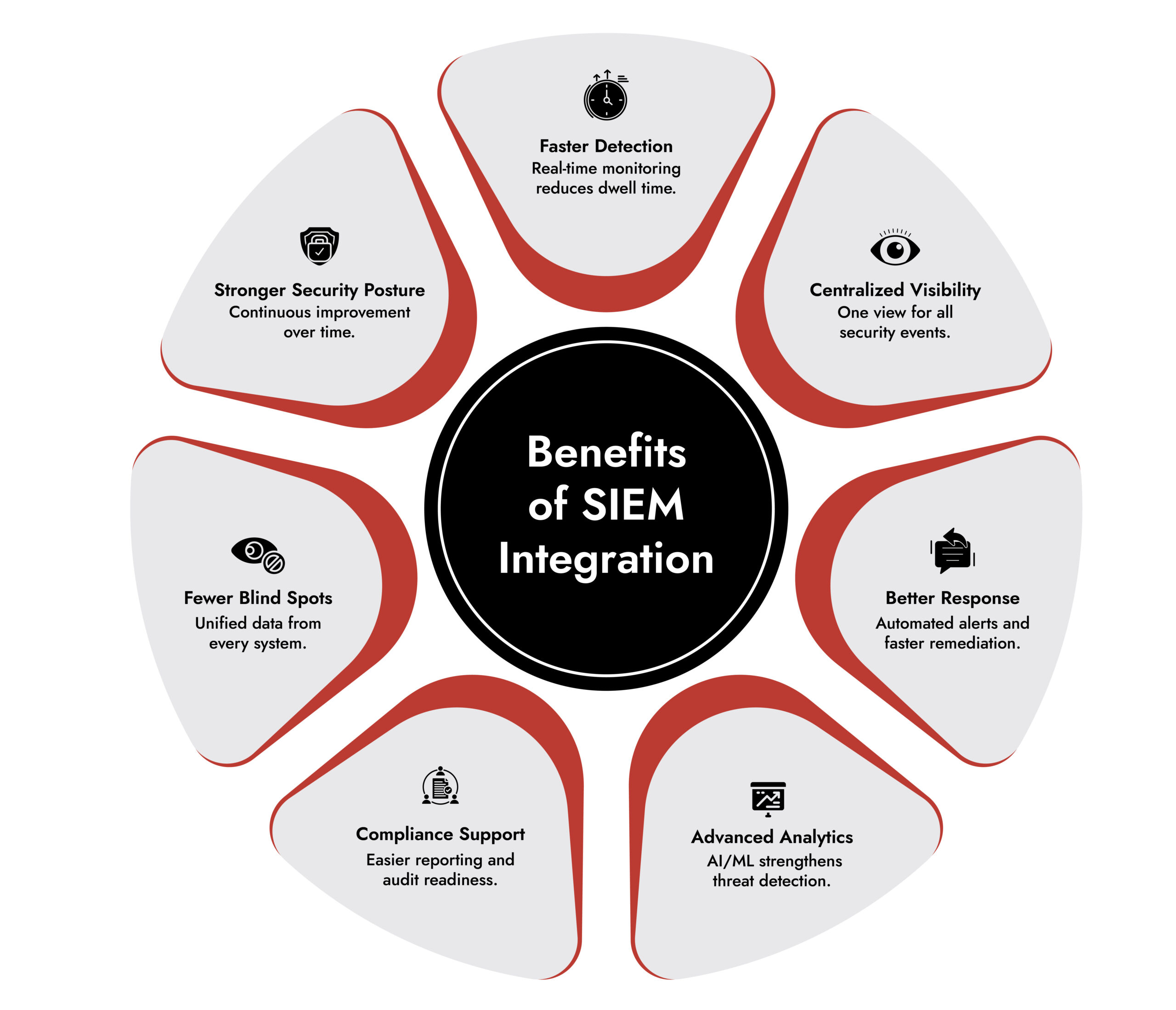
1. Improved Incident Response Times
One of the primary benefits of SIEM integrations is improved cyber incident response times. By having an integrated platform that can quickly detect and respond to potential threats, organizations can drastically reduce the amount of time it takes to detect and respond to incidents and minimize the damage caused by them.
2. Increased Visibility into Security Events
Another benefit of SIEM integration is increased visibility into security events. By integrating multiple sources of data, such as log files from systems, applications, databases and other sources, organizations gain a comprehensive view of their environment, which helps them identify potential threats more quickly and accurately. Having this level of visibility also allows organizations to prioritize security incidents based on their severity so they can address the most urgent ones first.
In short, SIEM integrations provide businesses with improved incident response times, increased visibility into security events, and automation of various security processes and responsibilities, which ultimately leads to a more secure environment for your organization. If you are looking for ways to strengthen your organization’s cybersecurity posture, then consider investing in an integrated SIEM solution. It could be just what you need.
What Are Some Challenges of SIEM Integrations?
SIEM technology is a powerful tool for organizations to have when it comes to protecting their environments and monitoring activity within them. However, there are some challenges associated with SIEM integrations that can make the process more difficult than anticipated. These challenges include the cost of implementation and maintenance, the complexity of deployment and operation, and the difficulty integrating new technologies. Let’s take a look at these challenges in more detail.
1. Cost of Implementation and Maintenance:
The cost associated with implementing a SIEM integration can be quite high due to the complexity of the environment itself. This is especially true if an organization has not previously used or deployed such a system before. Additionally, once implemented, maintaining a SIEM solution can also be costly due to the need for regular updates and upkeep, which often requires personnel dedicated solely to this task. As such, it is important for organizations to consider the cost of implementation and maintenance prior to deciding if this is the right solution for them.
2. Complexity of Deployment and Operation:
Another challenge that organizations face when considering a SIEM integration is the complexity associated with deploying and operating the SIEM system itself. This includes understanding how it works as well as setting up rules for alerting on potential threats or anomalies detected within the broader environment. Additionally, organizations must also understand what data sources will be utilized in order to obtain accurate information regarding collected logs. All of these steps must be taken prior to having an effective security monitoring solution in place.
3. Difficulty Integrating New Technologies:
Finally, another challenge associated with SIEM integrations is the difficulty integrating new technologies into existing systems or networks. As SIEM technology advances over time, so do threats, which means that organizations must ensure they are keeping up with these changes to remain secure. This may involve updating software or hardware as well as learning how to integrate new solutions into existing systems or networks, which can be quite difficult if not done properly. A common failure point for some SIEM platforms occurs where a monitored log source is updated to a new version and the SIEM networking no longer recognizes the new log format. As such, organizations should take extra care when considering any type of integration into their existing security solutions in order to avoid potential risks or vulnerabilities down the road.
SIEM technology is a key tool for any organization. It helps protect networks from outside threats. It also monitors activity within the network effectively. Using SIEM integration has many benefits, but it also comes with challenges. These challenges include the cost of setting it up and keeping it running. There is also the complexity of deploying and operating it. Additionally, integrating new technologies can be difficult. It is important to think about all these factors before making any decisions. This helps ensure a successful deployment and avoids risks later. With careful planning, effort, and research, utilizing SIEMs can be achieved without too much difficulty.
NetWitness can provide you with more than just SIEM integrations. We can help keep your organization protected from other threats with our other systems, such as security orchestration automation and response and even comprehensive extended detection response, or XDR. Contact NetWitness for more information.
Frequently Asked Questions
1. What is meaning of SIEM security?
SIEM security refers to the practice of using Security Information and Event Management tools to collect, analyze, and respond to security events across an organization’s IT infrastructure.
2. What are the steps in SIEM integration?
Typical steps include assessing data sources, defining use cases, configuring log collection, setting correlation rules, testing alerts, and continuous optimization.
3. What is SIEM integration?
A SIEM integration connects different security tools and data sources to a central SIEM platform for unified monitoring, analysis, and incident response.
4. How does SIEM network monitoring help?
SIEM network monitoring provides real-time visibility into network activity, helping detect anomalies, intrusions, and suspicious behavior quickly.
5. Why is SIEM integration critical for cybersecurity?
It ensures all security data flows into a single platform, enabling faster detection of threats and a more coordinated incident response.

